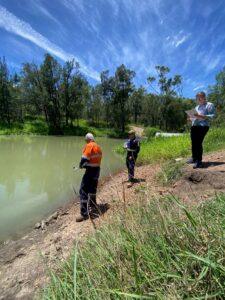As we navigate through the fiscal year, staying within the allocated budget for environmental monitoring programs is a priority. However, when it comes to water quality monitoring, the investment goes beyond the dollar figures on a spreadsheet. The true cost encompasses not only the equipment and personnel but also the time, effort, and expertise required to ensure accurate, impactful data that informs crucial water management decisions.
In this article, we’ll break down the key investments at each major step in the water quality monitoring process, shedding light on the broader picture of what it takes to deliver reliable and actionable data.
1. Initial Planning and Design
Water quality monitoring begins long before any sample is taken. A well-designed monitoring plan is essential to collecting relevant and consistent data. This step involves:
- Identifying Objectives: Clarifying what you need to measure and why. Different goals require different parameters, whether it’s tracking pollution sources, monitoring compliance with environmental regulations, or assessing ecosystem health.
- Selecting Locations and Timing: Choosing the right sampling sites and determining the frequency of testing. Missteps at this stage can lead to insufficient data, requiring additional rounds of sampling and inflating costs.
 Budgeting for Resources: Estimating how much equipment, personnel, and time will be required. While budget planning is critical, it’s also necessary to build flexibility for unexpected circumstances such as equipment failure or additional sampling requirements.
Budgeting for Resources: Estimating how much equipment, personnel, and time will be required. While budget planning is critical, it’s also necessary to build flexibility for unexpected circumstances such as equipment failure or additional sampling requirements.
While often considered an administrative task, this initial phase requires a blend of scientific insight and financial planning. Investing the time to carefully design the program ensures cost efficiency and data reliability down the line.
2. Equipment and Technology
The cost of equipment can vary significantly depending on the scope of the monitoring program. Key equipment includes:
- Water Quality Meters and Sensors: Devices that measure key parameters such as pH, dissolved oxygen, turbidity, and temperature. Higher-end meters may include features for real-time data transmission or logging, which reduce the need for frequent manual readings but increase upfront costs.
- Sampling Kits and Lab Equipment: Collecting water samples for lab analysis requires various tools, such as bottles, coolers, and preservatives to maintain sample integrity. For more advanced testing, lab equipment like spectrophotometers or chromatographs may be necessary.
- Automated Monitoring Systems: For long-term or large-scale monitoring, automated systems with sensors that continuously collect and transmit data can be an invaluable investment. Although these systems reduce the need for frequent on-site sampling, they come with high upfront costs and require maintenance.
The equipment cost is a significant portion of the budget, but the quality and reliability of this technology determine the accuracy of your results. Cutting corners on equipment can lead to poor data quality, which could require resampling or even undermine the entire program.
3. Personnel and Training
Water quality monitoring requires skilled personnel to collect, process, and interpret data. Some key costs related to human resources include:
- Field Technicians: Personnel responsible for conducting on-site sampling. Fieldwork can be labor-intensive, especially in challenging environments like remote lakes or fast-moving rivers. The time spent in the field, travel expenses, and safety considerations all contribute to the overall cost.
- Training: Ensuring that field technicians are properly trained is essential. Incorrect sampling techniques can lead to inaccurate or unusable data. Continuous training on new equipment or updated regulations is another hidden cost often overlooked in budget planning.
- Data Analysts and Specialists: Once the samples are collected, trained analysts are needed to interpret the data. Whether in-house or outsourced, this expertise is crucial for transforming raw data into actionable insights.
Personnel costs are not just salaries; they also include travel, accommodation (for remote monitoring), and ongoing professional development. Without skilled staff, even the best equipment will fail to provide the quality of data needed for informed decision-making.
4. Data Collection and Management
Data collection doesn’t end with fieldwork. The process of managing, analyzing, and reporting the data is a critical—and often resource-intensive—part of water quality monitoring. The key components include:
- Data Logging and Storage: Depending on the volume of data, logging and storing results can require specialized software or cloud-based systems. These systems help manage large datasets but may require subscriptions or licenses, adding to long-term costs.
- Data Validation: Before data can be used for decision-making, it must be validated to ensure accuracy. This can involve double-checking field data, lab results, and ensuring that all parameters were measured correctly. This validation step, while necessary, can consume significant staff time and resources.
- Analysis and Reporting: Finally, data needs to be interpreted and turned into reports or dashboards that inform water management decisions. This often involves advanced statistical or modeling techniques that require specialized expertise and software.
The costs associated with data management are often underestimated but are crucial for ensuring that water quality monitoring programs deliver actionable, accurate information.
5. Maintenance and Calibration
To ensure continuous data accuracy, water monitoring equipment requires regular maintenance and calibration. These ongoing costs include:
- Calibration Materials: Sensors and meters need to be calibrated regularly to ensure accuracy, which requires calibration standards and buffers.
- Repairs and Replacement: Wear and tear on field equipment, especially in harsh environmental conditions, is inevitable. Regular maintenance and occasional equipment replacement are necessary to avoid interruptions in data collection.
- Software Updates: If using automated systems or digital meters, software updates and maintenance can also add to the operational costs. Keeping systems up-to-date ensures compatibility with newer data management tools and improved functionality.
6. Contingency Planning
No matter how well-planned, unexpected challenges can arise. Weather conditions, equipment failure, or logistical delays can impact the efficiency of water quality monitoring programs. Factoring in contingency costs—such as additional sampling rounds or replacing damaged equipment—ensures your program stays on track without overspending.
Understanding the true investment in water quality monitoring means looking beyond just the equipment price tags. A successful program requires careful planning, the right technology, skilled personnel, and a robust system for managing and analyzing data. By accounting for all these factors—time, effort, resources, and expertise—organizations can develop more efficient, accurate, and cost-effective water quality monitoring programs that provide reliable data to inform water management decisions.
Investing wisely in every stage of the process ensures not only financial sustainability but also the continued protection and management of vital water resources.
Bronwyn Reid | 4t Consultants
October | 2024
